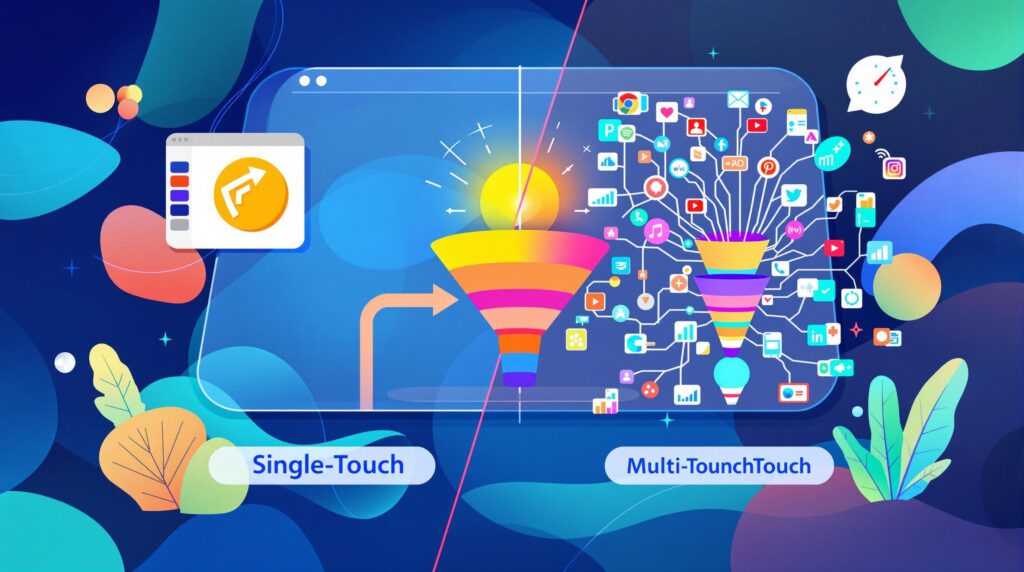Attribution models help businesses understand which marketing efforts drive customer conversions. The two main types are Single-Touch and Multi-Touch models:
- Single-Touch Attribution: Assigns 100% credit to one interaction (e.g., first or last touch). It’s simple and affordable but overlooks the full customer journey.
- Multi-Touch Attribution: Distributes credit across all touchpoints. Provides detailed insights but requires advanced tools and expertise.
Quick Comparison Table
| Aspect | Single-Touch | Multi-Touch |
|---|---|---|
| Implementation | Easy and quick setup | Complex setup, more effort |
| Data Requirements | Basic tracking tools | Advanced multi-channel data |
| Cost | Lower investment | Higher investment |
| Best For | Simple campaigns, short sales cycles | Multi-channel strategies, complex journeys |
| Accuracy Level | Basic attribution | Detailed customer journey insights |
| Resource Needs | Minimal technical expertise | Advanced analytical skills |
Key Takeaway
Single-Touch models are great for simplicity and quick insights, while Multi-Touch models excel in mapping complex customer journeys but demand more resources. Choose based on your goals, budget, and campaign complexity.
Single-Touch Attribution Models Explained
Single-Touch Attribution Overview
Single-touch attribution gives all the credit for a conversion to just one interaction in the customer journey. Unlike multi-touch models that evaluate the entire path, this approach focuses on a single, key moment. It’s especially helpful for identifying specific stages in the marketing funnel, such as the first time a customer discovers your brand or the final step before they convert.
Types of Single-Touch Models
There are three main types of single-touch attribution models, each suited to different goals:
- First Touch: Assigns credit to the first interaction, making it useful for understanding how customers are acquired.
- Last Touch: Focuses on the final interaction, helping to analyze what drives conversions.
- Last Non-Direct Touch: Attributes credit to the last non-direct channel before conversion, offering insights into the role of referral or indirect channels.
Pros and Cons of Single-Touch Models
Single-touch models are simple to use and provide clear insights into specific parts of the funnel. However, they often overlook the complexity of customer journeys, leaving out important touchpoints that can lead to budget misallocations.
| Aspect | Advantages | Limitations |
|---|---|---|
| Implementation | Simple to set up and manage | Oversimplifies customer journeys |
| Data Analysis | Provides clear and focused insights | Ignores contributions from other touchpoints |
| Resource Requirements | Requires minimal technical effort | Lacks depth in understanding customer behavior |
| Decision Making | Offers quick insights for key stages | May result in incomplete optimization |
| Cost Efficiency | Affordable to implement | Risks misallocating marketing budgets |
This approach works well for businesses with short sales cycles or straightforward customer journeys. However, it may fall short when dealing with the more complex paths typical of modern consumers. Multi-touch attribution can help fill those gaps [1][3].
Multi-Touch Attribution Models Explained
Multi-Touch Attribution Overview
Multi-touch attribution takes a broader view than single-touch models by analyzing how all touchpoints contribute to a conversion. It distributes credit across these touchpoints using methods like Linear Attribution (equal credit to all), Time-Decay (more weight to recent interactions), and U-Shaped (emphasis on the first and last touches).
This approach shows how different marketing channels work together to drive results. For instance, a customer might first see a social media ad, later read a blog post, and finally convert via a retargeting ad. Multi-touch attribution highlights the role each channel plays in the overall process.
Pros and Cons of Multi-Touch Models
Multi-touch attribution provides valuable insights but comes with its own challenges. Here’s a closer look:
| Aspect | Advantages | Limitations |
|---|---|---|
| Data Analysis | Maps out the entire customer journey | Requires clean data and advanced tools |
| Decision Making | Helps allocate budgets more precisely | Complex analysis can slow decisions |
| Implementation | Delivers a complete view of campaigns | Needs significant technical resources |
| Marketing Strategy | Improves campaign planning | Higher costs and resource demands |
To implement multi-touch attribution effectively, businesses need advanced tools, accurate data, and skilled analysts. While it can provide detailed insights to improve campaigns, the process can be resource-heavy [2][3].
The real question is whether the added complexity and costs are worth the deeper insights. This decision depends on a company’s goals, technical expertise, and marketing priorities [6][3]. Multi-touch attribution can be a game-changer, but only if it aligns with your business’s specific needs and capabilities.
Choosing the Right Attribution Model
Factors to Consider When Choosing
The best attribution model for your business depends on your marketing goals, complexity, and available resources. If you’re running straightforward campaigns, single-touch models are a simple and effective choice. However, for businesses with multi-channel strategies, multi-touch models provide deeper insights into customer behavior.
Single-touch models are easier to set up and require fewer resources, while multi-touch models demand more advanced tools and expertise. Your goals also play a critical role: single-touch models work well for tracking immediate conversions, whereas multi-touch models are better for understanding long-term customer journeys [1][3].
Here’s a side-by-side look at single-touch and multi-touch attribution models to help you decide.
Single-Touch vs Multi-Touch Models Comparison
| Aspect | Single-Touch Models | Multi-Touch Models |
|---|---|---|
| Implementation | Quick and easy setup | Requires a complex setup and more effort |
| Data Requirements | Basic tracking tools | Advanced tracking across multiple channels |
| Cost | Lower investment | Higher investment in tools and expertise |
| Best For | Simple campaigns, short sales cycles | Multi-channel strategies, complex journeys |
| Accuracy Level | Basic attribution | Detailed insights into customer journeys |
| Resource Needs | Minimal technical expertise | Advanced analytical skills |
Using Growth-onomics for Attribution

Growth-onomics offers a customer journey mapping service that’s perfect for businesses ready to shift from single-touch to multi-touch attribution. They assist by:
- Evaluating your current marketing channels and data collection methods
- Recommending the best attribution model based on your goals
- Setting up advanced tracking systems for precise attribution
With their data analytics services, Growth-onomics helps businesses understand attribution data and make smarter marketing decisions. This is especially useful for navigating the complexities of multi-touch attribution systems [1][3].
Keep in mind, your choice of attribution model doesn’t have to be final. Many businesses start with single-touch models and gradually move to multi-touch as their strategies grow and their resources expand [4][5].
sbb-itb-2ec70df
Types of Marketing Attribution Models: Definition & How to Choose
Conclusion
Attribution modeling plays a key role in understanding marketing performance and improving campaign results.
Key Takeaways
Single-touch models are straightforward and cost-effective but offer limited insights. On the other hand, multi-touch attribution provides a broader view but comes with greater complexity and expense [1][3]. The right choice depends on your business’s goals, resources, and the intricacy of your marketing efforts [4][5].
Here are some factors to consider for effective attribution:
- Align your attribution method with the complexity of your sales cycle.
- Ensure attribution insights support your business goals.
- Maintain accurate and reliable data across tracking systems.
- Adapt marketing strategies based on attribution findings.
- Leverage attribution data to improve channel efficiency and budget use.
Growth-onomics specializes in helping businesses set up and manage attribution models. Their expertise in data analytics and mapping customer journeys ensures accurate tracking and actionable insights [1][3].
Attribution strategies can grow alongside your business. Many companies begin with simpler models and move to more advanced ones as their needs and capabilities evolve [4][5].
Check out the FAQs below for more detailed answers to common attribution-related queries.
FAQs
Here are answers to common questions to help you understand the key differences between attribution models and decide which one fits your business needs.
What are the differences between single-touch and multi-touch attribution models?
Single-touch attribution gives all the credit for a conversion to one specific touchpoint in the customer journey. In contrast, multi-touch attribution spreads the credit across multiple touchpoints, offering a broader view of how various marketing channels contribute to conversions [1][3].
For example, imagine a customer first clicks on a Facebook ad and later completes a purchase through a Google ad. With single-touch attribution, either the first interaction (Facebook) or the last interaction (Google) gets 100% of the credit. Multi-touch attribution, however, acknowledges the role of both touchpoints in driving the conversion.
Single-touch models are straightforward and focus on one interaction, making them a good fit for simpler campaigns or when analyzing the beginning or end of the customer journey. Multi-touch models, on the other hand, deliver a broader perspective but require advanced tools and more resources to analyze multi-channel strategies effectively [4][5].
"Single-touch attribution is easier to implement and can help evaluate specific stages of the customer journey, but it lacks the nuanced insights of multi-touch attribution." [3]
The right choice depends on your business goals, available resources, and the complexity of your marketing campaigns.









